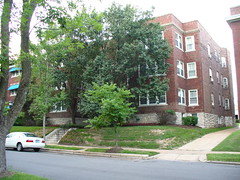In my last few posts, I’ve mentioned optical mapping and optical coherence tomography (OCT). Given just the names it’s not actually obvious that they’re entirely different things. Thus, I thought I should explain them.
Optical Mapping
“Optical Mapping” is short for something like “Optical mapping of voltage on the surface of the heart using fluorescence from potentiometric dyes”. The short version is ambiguous, as it could mean optical mapping of all kinds of stuff, and could in fact be synonymous with OCT. When cardiac electrophysiologists refer to an optical mapping study, what that usually involves is the following.
A heart is mounted in a clear chamber of some kind, and instrumented appropriately for whatever experiment is being done (say, defibrillation). A dye is then injected into the fluid flowing through the heart, typically “Tyrode’s” solution, which is kind of like blood without proteins and blood cells. This dye is fluorescent, meaning that when a certain color of light shines on it, it absorbs that light but then releases light of a different color. The cool (and useful) thing is that the amount of light released depends on the voltage gradient across the dye. It is designed to sit across the membrane of a cell, so by measuring changes in light released, it’s possible to measure changes in the electrical potential across the cell membrane, and to thereby monitor excitation, arrhythmia, and so on without electrodes. Using a fast, high-resolution camera, it is thereby possible to measure electrical activity in the heart from many more points, and at much better resolution, than using a bunch of electrodes. The major downside of optical mapping is that it is essentially limited to surfaces. Electrodes are still needed to probe the depths of the myocardium. Alternatively, optical mapping experiments can be combined with simulation experiments. We contend that if the sufrace activity of the simulation matches the suface activity of the experimental preparation “reasonably” well, the simulated activity within the walls should be a good approximation of what’s going on inside the experimental heart.
Optical Coherence Tomography
Typically referred to as OCT, the easiest way to explain it is that it’s like ultrasound imaging, but with light. In reality it gets a little more complicated. Wikipedia has a pretty good explanation. We’re using it to scan the thin right-ventricular free wall of the rabbit heart, and are then going to make and use computational models based on the resulting data. To do that, we have to segment the images (determine what is tissue, what is not), and then analyze them to create a finite element mesh.


